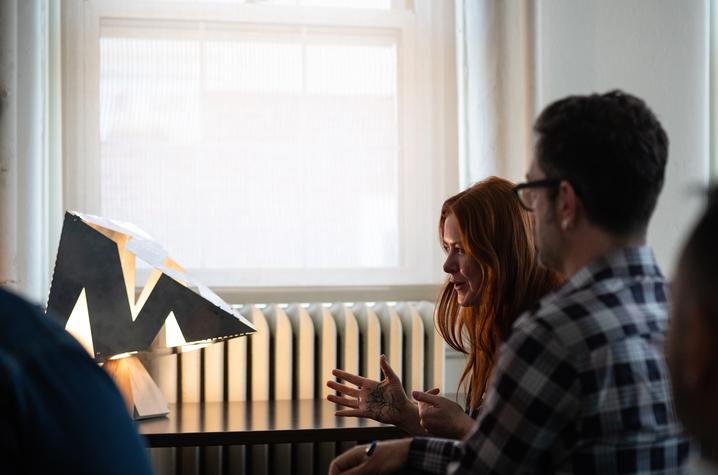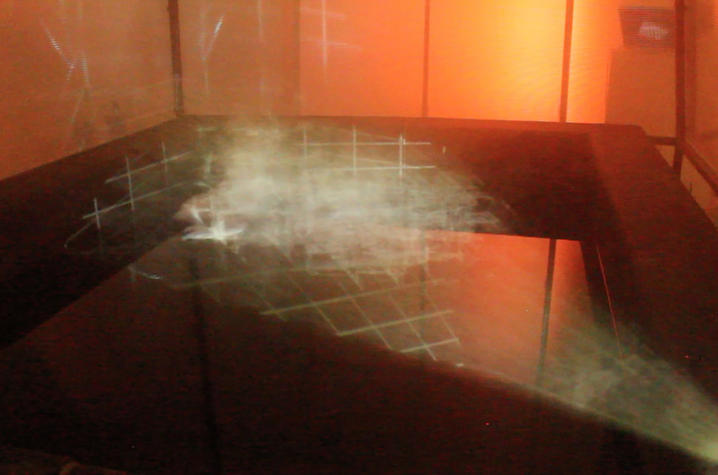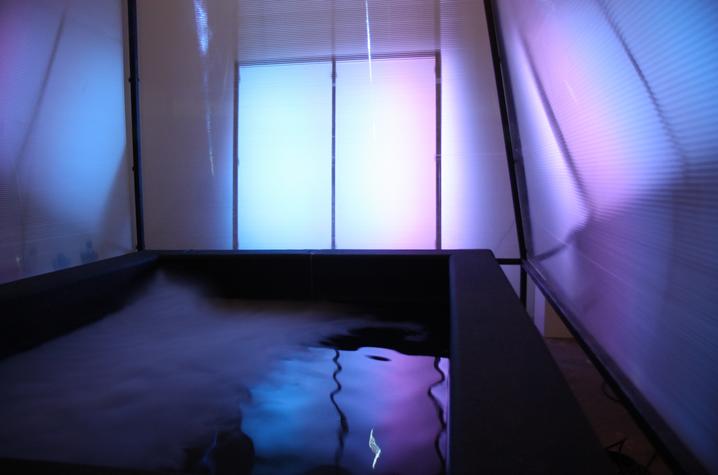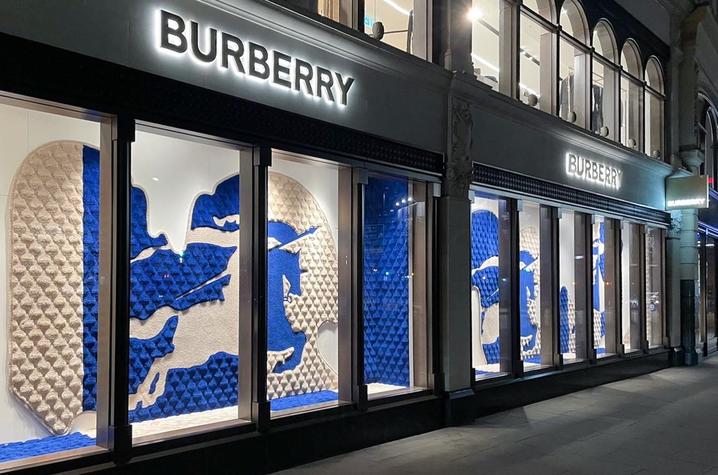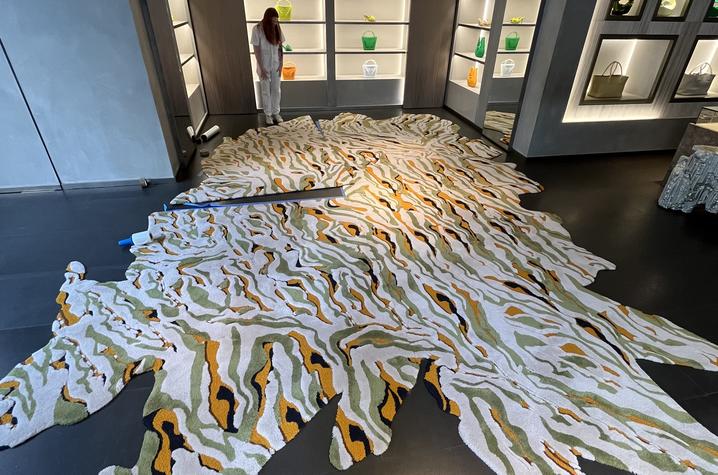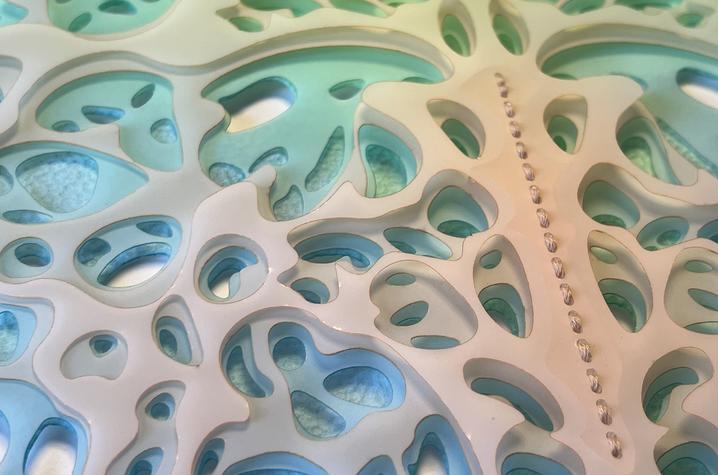Women Making History: UK researcher champions thinking through making
LEXINGTON, Ky. (March 29, 2024) — In a workshop in the University of Kentucky College of Design, you’ll find one researcher meticulously crafting. It’s part of her process: thinking through making.
Hannah Dewhirst is a designer, co-founder of SUBSTUDIO and an assistant professor in the School of Interiors in the College of Design. She is an advocate of creative scholarship with her students and emphasizes learning through creating.
“For my own work, I’ll typically find a tool that I’m interested in — a type of material, a laser cutter, a CNC router or a tufting gun — and then use that tool to create a large array of different outputs,” said Dewhirst.
The designer’s research interests revolve around creating experiential, immersive and sensorial environments. To accomplish that, Dewhirst often isolates elements like water, light or color in her designs and manipulates them in interesting ways.
“The goal is to reach at these things that feel impossible spatially: to try to get the body outside of its normal environment and into one that allows you to become more introspective or maybe slightly more directionalized toward a specific environmental factor,” said Dewhirst.
One of those environments Dewhirst built was a sensory deprivation water tank with 1,200 pounds of Epsom salt in it, so the person inside floats. The designer could then isolate or spotlight certain elements to study and develop new experiences.
“It’s a rich and challenging thing to balance this type of research; to figure out your own relationship to a sensory experience versus somebody else’s.”
Lately, Dewhirst has been working with softer materials and soft goods which caught the eye of commercial clients like fashion companies Burberry and Bottega Veneta. Her work through SUBSTUDIO, a practice with assistant professor Ingrid Schmidt, has lived in retail spaces for the companies. You can see examples of that work in the photo slideshow above.
The initial stage of that product started with Dewhirst using the rug tufting practice to make a connection between handcraft and tools of digital fabrication. First working with a hand punch needle, Dewhirst graduated to an automated tufting gun and then to robotic tufting at a much larger scale.
“There was just so much embedded knowledge that I had because I had worked with the materials in my studio so much. Had I jumped to large-scale production I would’ve lost that,” she said. “There's a process of really developing an intimate knowledge of a material by working with it for a long time and iterating and fine-tuning that thing so that it is giving me something experientially.”
It’s a similar process she teaches her students.
“The ‘thinking through making’ research methodology is relevant to my own teaching pedagogy,” said Dewhirst, who teaches undergraduate and graduate design students. “Students using tools of digital fabrication, tools of handcraft and actually researching through the process of making rich and very experiential spaces is very much linked to my own research practice and how I make space, too.”
Dewhirst’s background is in architecture, earning her master’s degree from Cranbrook Academy of Art in Bloomfield Hills, Michigan. Her decision to shift into interiors was deliberate because of the direct relationship with material manipulation and the ability to experiment with materials and experience of space.
“Interiors is inherently a very female-centric field in comparison to architecture. There are more women who exist in this field,” said Dewhirst. “It has been very empowering to work with materials and tools in this context because I feel like historically, the manipulation of these materials within the context of interior design has often taken a secondary role to the more historically respected, male-dominated field of architecture. There is a lot to unpack there.”
The designer is not intimidated by tools, but instead is excited to master them and share that knowledge with others. “That’s something I’ve been highly focused on — introducing these ideas to women and students who typically may not feel they have ownership over a shop environment and encouraging them to work with their hands, work with tools and not feel intimidated by a shop. It’s empowering to be here in a female-centric field and flipping the script a little bit in terms of who gets to use what tools,” said Dewhirst.
The collaboration with Schmidt through SUBSTUDIO affords Dewhirst opportunities to make space for women who make things in the field of design.
“I think just by the pure nature of us teaching and practicing in the world, we keep trying to make a larger space for those who come after us,” said Dewhirst. “It’s amazing to see students now that I've taught for four years working with their hands in the same way and feeling empowered by the process of working with these tools.”
Dewhirst credits that lesson in autonomy in learning and career choices to two key mentors: Bill Massie, now an associate professor in the College of Design who was previously at Cranbrook, and Heather McGill, the head of the sculpture department at Cranbrook.
“Those two are really intelligent makers and crafters and builders and architects,” said Dewhirst. “They taught me how to be the maker of my own career.
“It’s something I work to be intentional about with my students now, to help them find the motivation within themselves. That’s what lets you practice for life and not hunt for a job just to work. I feel like finding some sort of passion within the field is important and has been important to me as well.”
Equally important to Dewhirst is the art of regular practice. “Make something every day and develop a depth of knowledge about the thing that you're working with,” she said. “Try to not be predictive about how things should be or could be, but really do the work to get there and learning through the act of making.”
Dewhirst’s advice for both students and future women in research is to combine passion with practice.
“Unless you start, you’ll never get there,” she said. “You'll be too hesitant or afraid that something will be wrong. But of course, it will be wrong. You just have to continue to work with it until it's fine-tuned and it's right, or it feels more right than it did at the beginning. Only through that practice of iteration, I think, do you realize what works for you and what doesn’t.”
As the state’s flagship, land-grant institution, the University of Kentucky exists to advance the Commonwealth. We do that by preparing the next generation of leaders — placing students at the heart of everything we do — and transforming the lives of Kentuckians through education, research and creative work, service and health care. We pride ourselves on being a catalyst for breakthroughs and a force for healing, a place where ingenuity unfolds. It's all made possible by our people — visionaries, disruptors and pioneers — who make up 200 academic programs, a $476.5 million research and development enterprise and a world-class medical center, all on one campus.





